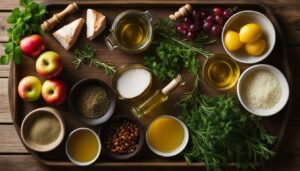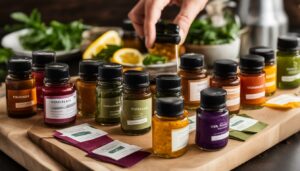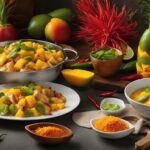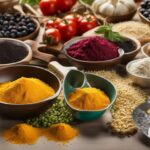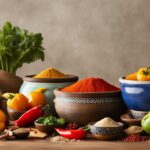When a recipe calls for vanilla, what does that mean? How should you use vanilla in your cooking and baking? And are there any substitutes for vanilla extract? Vanilla is a versatile and widely used ingredient in many recipes, but it can sometimes be challenging to navigate its various forms and understand how best to incorporate it into your dishes. In this guide, we will explore the different types of vanilla, its flavors, and its applications in both sweet and savory recipes. Get ready to unlock the secrets of vanilla and take your culinary creations to the next level.
Contents
- 1 What is Vanilla Extract?
- 2 Other Forms of Vanilla
- 3 Using Vanilla in Baking
- 4 Substitutes for Vanilla Extract
- 5 Understanding Vanilla Flavors
- 6 Enhancing Culinary Dishes with Vanilla
- 7 Tips for Using Vanilla in Recipes
- 8 Storing and Preserving Vanilla
- 9 Exploring the World of Vanilla
- 10 Conclusion
- 11 FAQ
- 11.1 What does it mean when a recipe calls for vanilla?
- 11.2 What is vanilla extract?
- 11.3 Are there other forms of vanilla that can be used in recipes?
- 11.4 How can vanilla be used in baking?
- 11.5 What are some substitutes for vanilla extract?
- 11.6 Are there different flavors of vanilla?
- 11.7 Can vanilla be used in savory dishes and beverages?
- 11.8 What tips are there for using vanilla in recipes?
- 11.9 How can vanilla be stored and preserved?
- 11.10 Where does vanilla come from?
- 11.11 What are some uses and benefits of vanilla in recipes?
- 12 Source Links
Key Takeaways:
- Vanilla extract is the most common form of vanilla used in recipes.
- There are other forms of vanilla, such as vanilla pods, vanilla paste, and vanilla powder, each with its own unique properties and flavors.
- Vanilla is a staple ingredient in baking, adding depth and sweetness to cookies, cakes, and pastries.
- If you don’t have vanilla extract, there are several substitutes you can use, such as vanilla bean paste or vanilla powder.
- Understanding the different types of vanilla flavors, such as floral vanilla, bourbon vanilla, and Tahitian vanilla, can help you select the right one for your recipe.
What is Vanilla Extract?
Vanilla extract is the most common form of vanilla used in recipes. It is made by soaking or macerating vanilla beans in alcohol, typically vodka, to extract the flavor compounds. The resulting liquid is then filtered and bottled.
Vanilla extract has a strong, sweet, and aromatic flavor that enhances the taste of baked goods and desserts. It is often added to batters, doughs, and sauces to impart a distinct vanilla flavor. The concentration of vanilla extract can vary, but it is generally used in small amounts due to its intense flavor.
| Form | Description | Concentration of Vanilla Flavor | Usage |
|---|---|---|---|
| Vanilla Extract | Extracted from vanilla beans soaked in alcohol | High concentration | Small amounts in baked goods and desserts |
| Vanilla Pods | Whole dried fruits of the vanilla plant | Natural form; seeds scraped | Infuse flavors in custards or creams |
| Vanilla Paste | Combination of vanilla extract and scraped vanilla seeds | High concentration | Substitute for vanilla extract in recipes |
| Vanilla Powder | Dried and ground vanilla beans | Variable concentrations | Substitute for vanilla extract or add speckled appearance |
Vanilla extract is a versatile and essential ingredient in culinary creations, offering a concentrated dose of vanilla flavor. Its use elevates the taste and aroma of various recipes, delivering a delightful sweetness and aromatic touch.
Other Forms of Vanilla
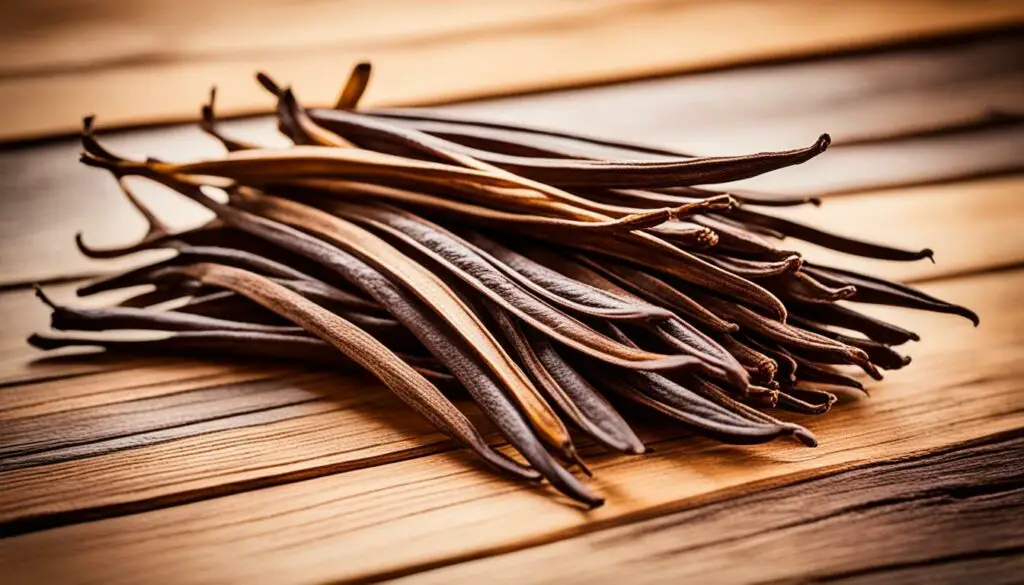
In addition to vanilla extract, there are other forms of vanilla that can be used in recipes. These alternatives offer unique flavors and can add a touch of creativity to your culinary creations.
Vanilla Pods
Also known as vanilla beans, vanilla pods are the whole dried fruits of the vanilla plant. They have a rich and complex flavor that can elevate your dishes. To use vanilla pods, simply split them open and scrape out the seeds. These seeds can be added directly to your recipes, providing a burst of intense vanilla flavor.
Vanilla Paste
Vanilla paste is a convenient alternative to using whole vanilla pods. It is made by combining vanilla extract with the seeds scraped from vanilla pods. The result is a thick and concentrated form of vanilla that adds depth and richness to your recipes. Vanilla paste is especially great for recipes where you want visible specks of vanilla.
Vanilla Powder
Vanilla powder is another versatile form of vanilla. It is made by drying and grinding vanilla beans into a fine powder. This powder can be used as a substitute for vanilla extract or to add a speckled appearance to recipes. Vanilla powder is ideal for recipes where you want to infuse the flavor of vanilla without adding additional liquids.
These different forms of vanilla offer varying intensities and nuances of flavor, allowing you to experiment and customize your dishes. Whether you choose to use vanilla pods, vanilla paste, or vanilla powder, each option brings its own unique qualities to the table.
Using Vanilla in Baking
Vanilla is a versatile ingredient that plays a crucial role in enhancing the flavors of various baked goods. Whether you’re baking cookies, cakes, or pastries, incorporating vanilla can take your creations to the next level.
Baking with Vanilla
When it comes to baking with vanilla, the possibilities are endless. The rich and aromatic flavor of vanilla adds depth and sweetness to a wide range of treats, making them irresistible.
“Using vanilla in my baking has been a game-changer. It brings out the natural sweetness in the ingredients and adds a wonderful aroma. I can’t imagine baking without it!” – Sarah, avid baker
Vanilla in Cookies
One of the most popular uses of vanilla in baking is in cookies. Whether you’re making classic chocolate chip cookies, delicate sugar cookies, or hearty oatmeal cookies, adding vanilla to the dough will enhance their flavor profiles.
Vanilla extracts infuse the cookies with a warm and inviting aroma while adding a subtle sweetness. The combination of the buttery dough and the aromatic vanilla creates a perfect balance that will leave everyone wanting more.
Vanilla in Cakes
Vanilla is also a key ingredient in cake recipes. From decadent vanilla cakes to rich chocolate cakes, adding a touch of vanilla to the batter elevates the overall taste and aroma.
The subtle warmth of the vanilla complements the other flavors in the cake, allowing them to shine. It brings out the natural sweetness and adds a depth of flavor that makes every bite memorable.
Vanilla in Pastries
In the world of pastries, vanilla is a staple ingredient in fillings, creams, and frostings. Its delightful taste enhances the overall experience of indulging in éclairs, cream puffs, tarts, and more.
Just a hint of vanilla can transform a simple pastry into a mouthwatering delight. The creamy and aromatic notes of vanilla create a harmonious fusion of flavors that will leave you wanting one more bite.
Discover the Magic of Vanilla in Baking
Whether you’re baking cookies, cakes, or pastries, incorporating vanilla is a surefire way to elevate your creations. Its sweet and aromatic flavor adds a touch of magic to every bite.
So the next time you’re in the kitchen, don’t forget to reach for that bottle of vanilla extract or those fragrant vanilla beans. Your taste buds will thank you!
Substitutes for Vanilla Extract

In some cases, you may find yourself without vanilla extract or prefer to use a substitute. There are several options to consider when looking for alternatives to vanilla extract. One option is to use vanilla bean paste, which provides a concentrated vanilla flavor and a texture similar to vanilla extract. Another substitute is vanilla powder, which can be used as a direct replacement for vanilla extract in recipes. Additionally, you can use vanilla essence, a synthetic form of vanilla flavoring that may not have the same complexity as natural vanilla extract but still imparts a distinct vanilla taste. Other possible substitutes include almond extract, maple syrup, or even a small amount of coffee or cocoa powder, depending on the desired flavor profile of the recipe.
When you run out of vanilla extract, don’t worry! There are plenty of alternatives to ensure you still achieve that delicious vanilla flavor in your recipes. Let’s explore some of the best substitutes for vanilla extract:
1. Vanilla Bean Paste
Vanilla bean paste is made from ground vanilla beans mixed with a sweetener, such as sugar or corn syrup. It offers a concentrated vanilla flavor and a texture similar to vanilla extract. Use an equal amount of vanilla bean paste as you would vanilla extract in your recipe.
2. Vanilla Powder
Vanilla powder is made from dried and ground vanilla beans, allowing you to easily substitute it for vanilla extract in recipes. Use the same measurement as you would for vanilla extract to maintain the desired flavor intensity.
3. Vanilla Essence
Vanilla essence is a synthetic form of vanilla flavoring that can be used as a substitute for vanilla extract. While it may not have the same complexity as natural vanilla extract, it still imparts a distinct vanilla taste. Follow the measurement guidelines provided on the packaging when using vanilla essence in your recipes.
4. Almond Extract
Almond extract can be used as a substitute for vanilla extract, especially in recipes where the nutty flavor complements the other ingredients. Start by using half the amount of almond extract as you would vanilla extract, as almond extract has a stronger flavor.
5. Maple Syrup
For a touch of sweetness and a hint of caramel-like flavor, maple syrup can be used as a substitute for vanilla extract. Use the same amount of maple syrup as you would vanilla extract to maintain the desired level of sweetness.
6. Coffee or Cocoa Powder
Depending on the flavor profile you’re looking for, a small amount of coffee or cocoa powder can add depth and complexity to your recipes as a substitute for vanilla extract. Add a teaspoon at a time to achieve the desired taste.
Experimenting with these different substitutes can provide unique flavors and enhance your recipes. While they may not replicate the exact taste of vanilla extract, they offer their own distinct profiles to elevate your culinary creations.
Understanding Vanilla Flavors
Vanilla is not a one-size-fits-all flavor. There are various types of vanilla that offer different flavor profiles and nuances.
Floral vanilla, often referred to as Madagascar vanilla, has a classic and well-rounded flavor with notes of caramel and chocolate.
Bourbon vanilla, also known as Tahitian vanilla, has a creamy and sweet flavor with hints of cherry and fig.
Tahitian vanilla is known for its floral and fruity flavor, featuring aromatic notes of cherry, prune, and anise.
It’s important to consider the type of vanilla being used when following a recipe, as it can impact the overall taste of the dish.
Exploring the Different Vanilla Flavors
Let’s take a closer look at the different types of vanilla flavors:
| Vanilla Flavor | Characteristics | Common Uses |
|---|---|---|
| Floral Vanilla (Madagascar Vanilla) | Classic, well-rounded flavor with notes of caramel and chocolate | Cakes, cookies, ice creams, custards |
| Bourbon Vanilla (Tahitian Vanilla) | Creamy, sweet flavor with hints of cherry and fig | Puddings, sauces, beverages, confections |
| Tahitian Vanilla | Floral and fruity flavor with aromatic notes of cherry, prune, and anise | Fruit desserts, tropical dishes, flavored syrups |
Enhancing Culinary Dishes with Vanilla
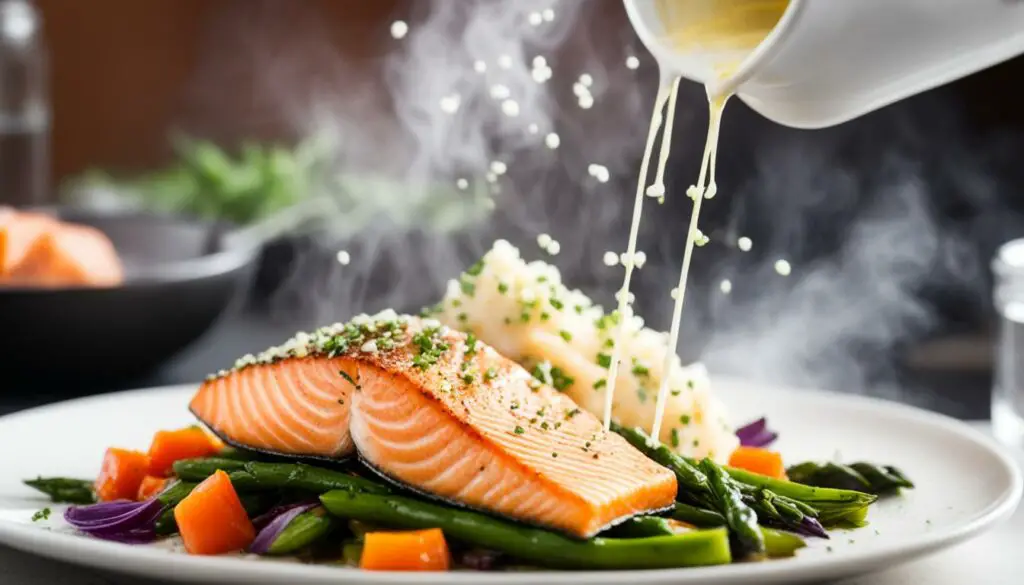
While vanilla is commonly associated with desserts, its versatility extends beyond sweet treats. The unique flavor and aroma of vanilla can elevate savory dishes and beverages, adding a subtle complexity to the overall culinary experience. Let’s explore how to enhance your favorite recipes with the magic of vanilla.
Savory Delights with Vanilla
When incorporated into savory dishes, vanilla imparts a delightful twist, enhancing the flavors of sauces, marinades, and more. A touch of vanilla can elevate seafood, poultry, and root vegetables to new heights, creating a delightful fusion of sweet and savory. The subtle complexity and aroma of vanilla complement a variety of savory flavors, making it a versatile ingredient in the kitchen.
Vanilla-Spiked Sauces
A drizzle of vanilla-infused sauce can take your savory dishes to the next level. Vanilla adds a unique depth and richness to sauces, creating a harmonious balance of flavors. Whether you’re preparing a creamy vanilla beurre blanc or a tangy vanilla-infused BBQ sauce, the addition of vanilla can transform ordinary dishes into extraordinary culinary creations.
Decadent Vanilla Beverages
Vanilla is not limited to culinary delights. It can also elevate your beverage game, whether enjoyed hot or cold. A fragrant vanilla latte, a refreshing vanilla iced tea, or a creamy vanilla smoothie can provide a delightful twist to your daily drinks. The warmth and aromatic essence of vanilla can create a comforting and indulgent experience, turning an ordinary beverage into a luxurious treat.
| Savory Dishes | Sauce Recommendations | Featured Beverage |
|---|---|---|
| Seafood | Vanilla-infused butter sauce | Vanilla-infused iced tea |
| Poultry | Vanilla-infused cranberry sauce | Vanilla-spiced hot cocoa |
| Root Vegetables | Vanilla-scented carrot puree | Vanilla-infused sparkling lemonade |
“The subtle complexity and aroma of vanilla complement a variety of savory flavors, making it a versatile ingredient in the kitchen.”
With a little creativity and a sprinkle of vanilla, you can take your culinary adventures to new heights. So go ahead, experiment with vanilla in your savory dishes and beverages, and discover a world of flavor possibilities.
Tips for Using Vanilla in Recipes

When incorporating vanilla into your recipes, it’s important to use it wisely to achieve the desired flavor balance. Here are some tips to help you make the most of this versatile ingredient:
- Measure carefully: Start by measuring the recommended amount of vanilla extract or other forms of vanilla specified in the recipe. This will ensure that you add the right amount of flavor without overpowering the other ingredients.
- Use vanilla beans or paste: If a recipe calls for vanilla beans or paste, scrape out the seeds and use them accordingly. This will add a rich and intense flavor to your dish.
- Adjust for concentration: Keep in mind that vanilla extract is typically more concentrated than other forms of vanilla. If you’re substituting vanilla extract with vanilla pods, paste, or powder, adjust the amount accordingly to maintain the desired flavor intensity.
- Balance other flavors: Vanilla is meant to enhance the overall flavor profile of your recipe, so be mindful not to overpower other flavors. Taste as you go and make adjustments as needed to achieve the perfect balance.
- Experiment and adapt: Don’t be afraid to experiment with vanilla in your recipes. Try different forms of vanilla and explore how they interact with different ingredients. You may discover new and exciting flavor combinations.
By following these tips, you’ll be able to utilize vanilla effectively and bring out its delightful flavor in your culinary creations.
Vanilla Usage Tips:
“Using vanilla in recipes requires skillful measurement and an understanding of its flavor characteristics. The key is to strike the right balance, allowing vanilla to complement other ingredients without overpowering them.”
| Tip | Description |
|---|---|
| Measure precisely | Ensure you use the recommended amount of vanilla extract or other forms of vanilla specified in the recipe to achieve the desired flavor balance. |
| Adjust for concentration | Be aware that vanilla extract is more concentrated than other forms of vanilla, so adjust quantities accordingly when substituting. |
| Strike a balance | Vanilla should enhance the overall flavor profile without overpowering other ingredients, so taste and make adjustments as necessary. |
| Experiment and adapt | Don’t be afraid to try different forms of vanilla and explore their interactions with various ingredients to discover exciting flavor combinations. |
Storing and Preserving Vanilla
Properly storing and preserving vanilla is crucial to maintain its flavor potency and extend its shelf life. Whether you have vanilla extract or vanilla beans, following these guidelines will ensure that your vanilla remains fresh and flavorful for longer.
Storing Vanilla Extract
When it comes to storing vanilla extract, it’s best to keep it in a cool and dark place, away from direct sunlight and heat. Consider storing it in a pantry or cabinet, where the temperature remains consistent. Heat and sunlight can cause the flavor compounds in vanilla extract to degrade over time, resulting in a loss of aroma and taste.
Preserving Vanilla Beans
To preserve vanilla beans, it’s important to store them in an airtight container. This helps prevent them from drying out and losing their moisture content. A glass jar with a tight-fitting lid works well for this purpose. Ensure that the container is clean and free from any moisture, as excess moisture can cause the beans to mold or spoil.
If you have extra vanilla beans and want to extend their shelf life further, consider placing them in a small jar with granulated sugar. The sugar will absorb the vanilla’s flavor and aroma, making it an excellent substitute for vanilla extract in certain recipes. This vanilla-infused sugar can be used to sweeten your coffee, tea, or even sprinkle over baked goods for a touch of vanilla goodness.
Summary
By storing vanilla extract in a cool and dark place and preserving vanilla beans in an airtight container, you can ensure that your vanilla maintains its full flavor potential. Taking these simple steps will help you enjoy the rich and aromatic taste of vanilla in your recipes for an extended period.
Exploring the World of Vanilla
Vanilla is a fascinating ingredient that has captivated culinary enthusiasts for centuries. Its origins can be traced back to Mexico, where the vanilla plant has been cultivated for thousands of years. However, today, vanilla is grown in various regions around the world, each contributing to the unique flavors and characteristics of this beloved ingredient.
Madagascar, known as the “vanilla capital of the world,” is one of the largest vanilla-producing regions. Its warm climate and rich soil create ideal conditions for vanilla cultivation. The vanilla beans from Madagascar are prized for their bold and creamy flavor, with hints of caramel and chocolate. They are often considered the gold standard in the vanilla industry.
Tahiti is another prominent region in the world of vanilla. Tahitian vanilla beans are renowned for their floral and fruity aroma, featuring aromatic notes of cherry, prune, and anise. The distinct flavor of Tahitian vanilla adds a unique touch to desserts and beverages, making it a favorite among chefs and bakers.
In addition to Madagascar and Tahiti, other tropical areas such as Mexico, Indonesia, and India also cultivate vanilla. Each region imparts its own terroir and expertise into the cultivation process, resulting in vanilla beans with different flavor profiles and nuances.
The cultivation of vanilla is a labor-intensive process that involves meticulous attention to detail. Vanilla plants require hand-pollination to ensure proper fruit formation, and the beans must be harvested at the precise time for optimal flavor development. After harvesting, the beans undergo a curing process, where they are dried and fermented to enhance their flavor compounds.
Exploring the world of vanilla allows us to appreciate the dedication and craftsmanship behind this exquisite ingredient. Whether it’s the bold and creamy flavors of Madagascar vanilla or the delicate floral notes of Tahitian vanilla, each region offers a unique and unforgettable taste experience. From desserts to beverages, vanilla continues to inspire culinary creativity and elevate our favorite recipes to new heights.
Vanilla beans are a precious commodity, and their cultivation and production involve a true artistry. The next time you reach for a recipe that calls for vanilla, take a moment to celebrate the origins and the hard work of the growers who bring this delightful flavor to our kitchens.
Conclusion
Vanilla is a versatile and essential ingredient that adds a delightful flavor and aroma to a wide range of recipes. Whether you’re baking sweet treats like cookies and cakes, or experimenting with savory dishes, vanilla can enhance the taste and elevate the flavors of your culinary creations.
Understanding the different forms of vanilla, such as vanilla extract, vanilla pods, paste, or powder, allows you to choose the right one for your recipe. Whether you’re using the rich and complex flavor of vanilla pods or the concentrated and convenient vanilla extract, it’s important to measure and balance the flavor to achieve the desired taste profile.
Don’t be afraid to get creative and explore the world of vanilla. Try incorporating vanilla in unexpected ways, such as adding a touch of vanilla to savory sauces or beverages. By experimenting with vanilla, you can unlock new layers of flavor and discover unique combinations that will impress your taste buds and those of your loved ones.
So, embrace the power of vanilla in your recipes and let it be your secret weapon in the kitchen. With its sweet and aromatic essence, vanilla is sure to bring joy and satisfaction to your cooking and baking adventures. Start exploring the possibilities and enjoy the delicious results that vanilla can bring to your favorite recipes.
FAQ
What does it mean when a recipe calls for vanilla?
When a recipe calls for vanilla, it typically refers to vanilla extract, which is a concentrated form of the vanilla bean.
What is vanilla extract?
Vanilla extract is made by soaking or macerating vanilla beans in alcohol, typically vodka, to extract the flavor compounds. It has a strong, sweet, and aromatic flavor that enhances baked goods and desserts.
Are there other forms of vanilla that can be used in recipes?
Yes, other forms of vanilla such as vanilla pods, vanilla paste, and vanilla powder can also be used in recipes, offering varying intensities and nuances of flavor.
How can vanilla be used in baking?
Vanilla is commonly used in cookies, cakes, and pastries to add depth and sweetness to the baked goods.
What are some substitutes for vanilla extract?
Possible substitutes for vanilla extract include vanilla bean paste, vanilla powder, vanilla essence, almond extract, maple syrup, coffee, or cocoa powder, depending on the desired flavor profile.
Are there different flavors of vanilla?
Yes, there are different flavors of vanilla such as floral vanilla (Madagascar vanilla), bourbon vanilla (Tahitian vanilla), and Tahitian vanilla, each with its own unique characteristics.
Can vanilla be used in savory dishes and beverages?
Yes, a touch of vanilla can add a subtle complexity and aroma to savory dishes and can be used to flavor hot or cold beverages.
What tips are there for using vanilla in recipes?
It’s important to measure vanilla extract or other forms of vanilla accurately and adjust the amount according to its concentration. Taste as you go and make adjustments to achieve the desired flavor balance.
How can vanilla be stored and preserved?
Vanilla extract should be stored in a cool and dark place, away from sunlight and heat, while vanilla beans should be stored in an airtight container. Placing vanilla beans in a jar with granulated sugar can also help preserve their flavor.
Where does vanilla come from?
Vanilla is native to Mexico and is now cultivated in various regions, including Madagascar, Tahiti, and other tropical areas.
What are some uses and benefits of vanilla in recipes?
Vanilla adds a delightful flavor and aroma to desserts, baked goods, and even savory dishes, enhancing their overall taste profile.



